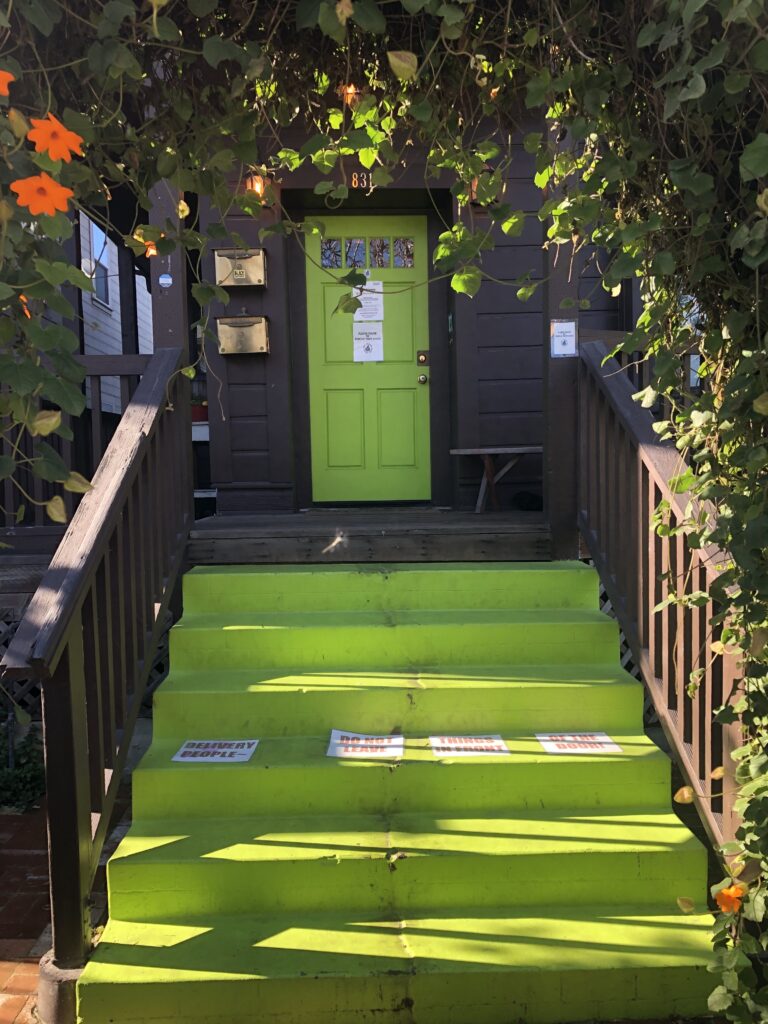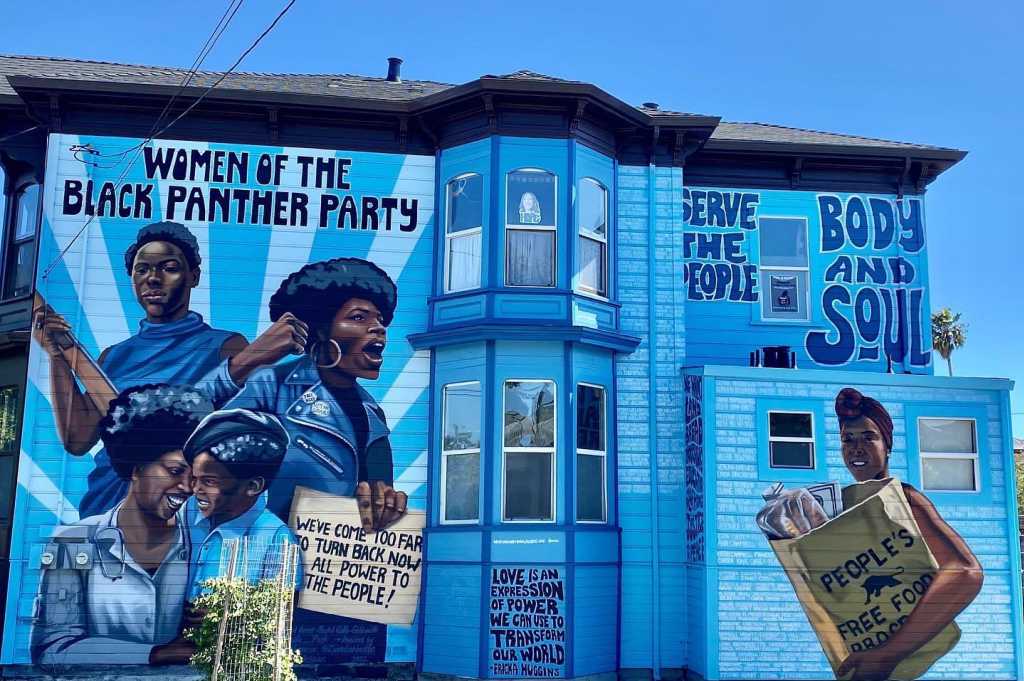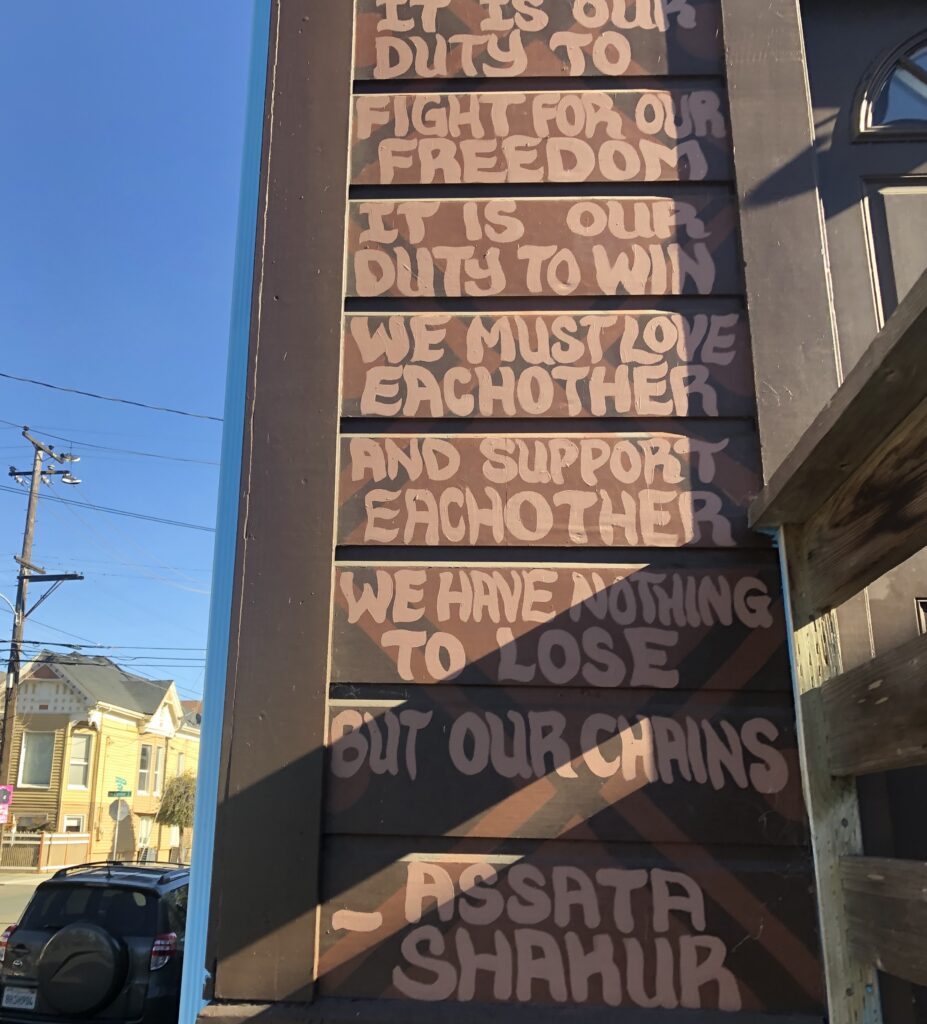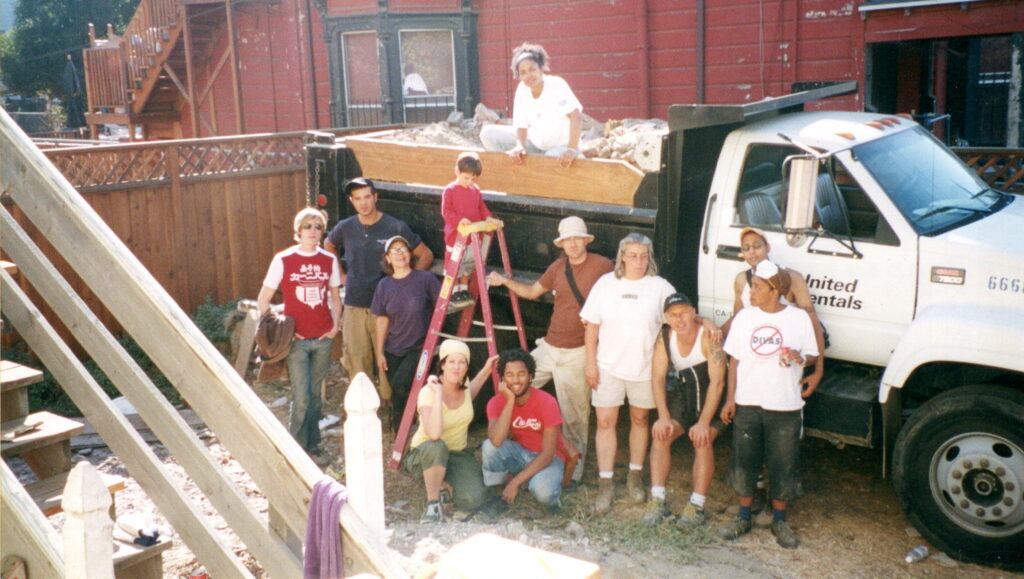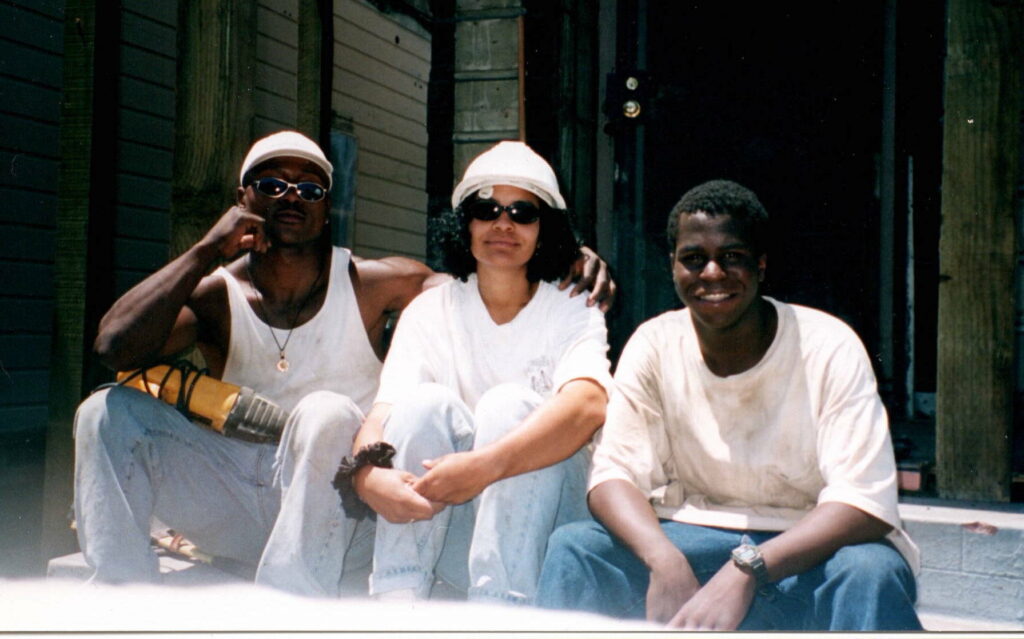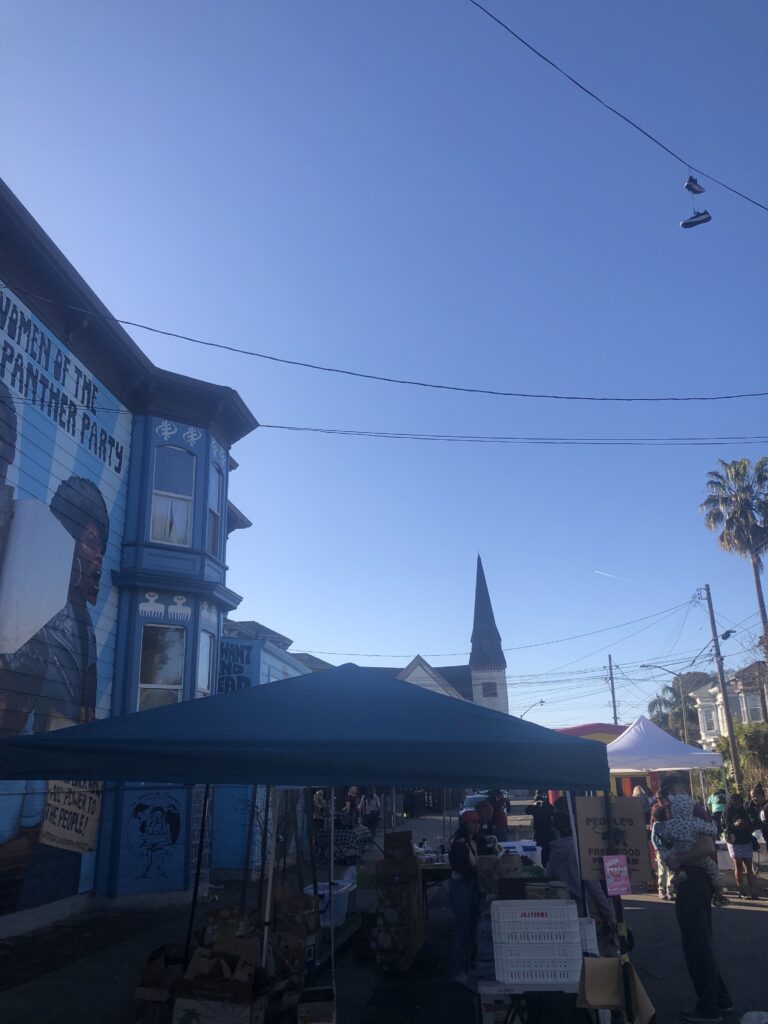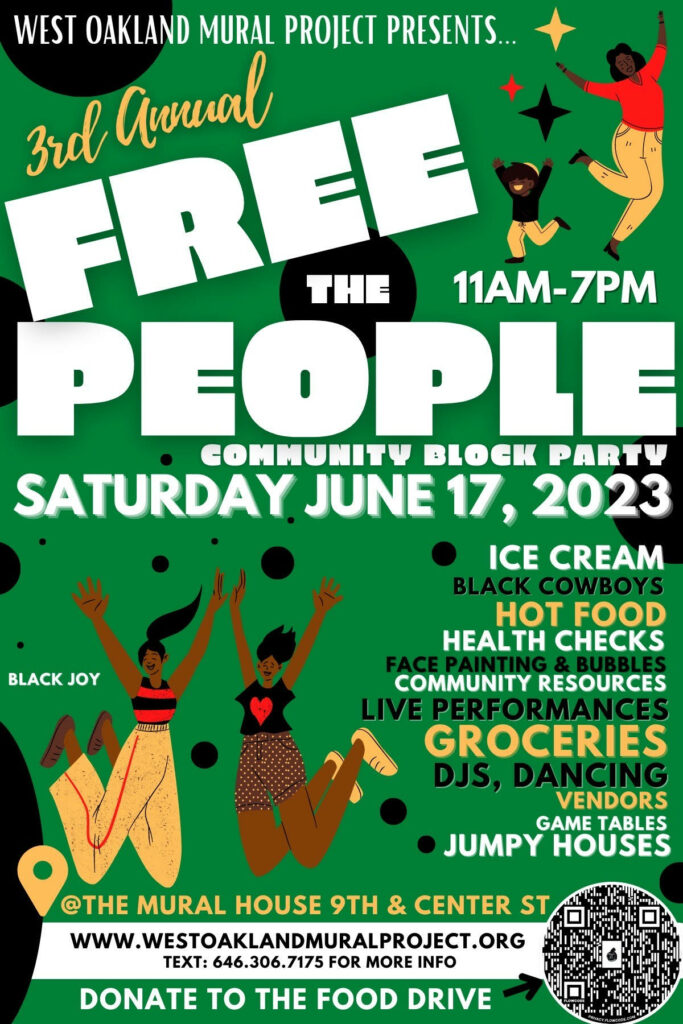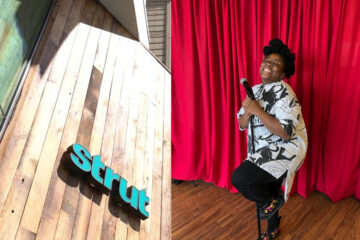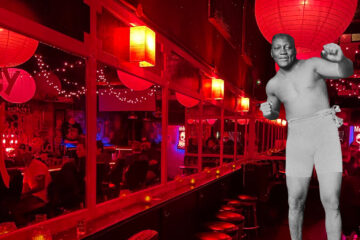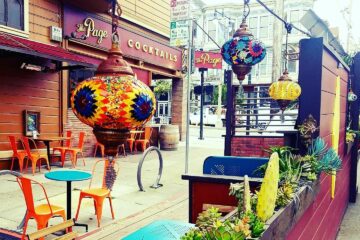The Bold Beautiful History of the West Oakland Mural House
Folks hanging out on their porch and greeting friends, family and passersby, has long been part of the nature of West Oakland. A man whose house I regularly walk by on my way to work once called out to me, “How do you make a Mai Tai?”
“You’ve got to have orgeat”, I called back. It was an amusing exchange, one of many, between neighbors, out on a day. This quality of street interaction however has changed much in the past years due to many long-time residents passing away, while others have been forced out. It’s also brought an influx of new people. Fences often reign and empty front yards proliferate.
But there is one front porch that continues to be a great locus of greeting and neighborhood congregation. That porch is at 831 Center street and is known as the Mural House – because emblazoned in brilliant blue and black, the colors stretching up to meet the Oakland sky, is a mural that honors the women of the Black Panther Party.
Inspired by the use of the black panther by the Alabama Lowndes County Freedom Organization as a symbol for civil rights activism, in 1966, Huey P. Newton and Bobby Seale helped to organize a political party, on the edge of the Pacific, in the potent city of Oakland, to fight for the Rights of Black Citizens.

Roadside billboard for the Lowndes County Freedom Party, 1966, Jim Peppler Southern Courier Photograph Collection, ADA
Activism in West Oakland was sorely needed post WWII. During the war, the region had seen a significant Black migration to work in the shipyards, on the docks, at the auto plants and even in the department stores. But by the late 60’s, due to racist development policies including redlining and the practice of eminent domain as well as many factory closures, the neighborhood had gone into severe decline. Jobs were scarce, schools were woefully underfunded and racially motivated violence, particularly by police, was rampant. Aid was not forthcoming from either the local or the federal government and so the community took matters into their own hands.
12 years ago I had the honor of interviewing Karema Bay, the mother of my friend Duo – a local poet and expert vintage typewriter repairman. Though part of the Black Panther’s Chicago chapter rather than the Oakland founding, she helped with one of the most vital aspects of the party – the People’s Free Food Program. The program sought to feed many, but the main agenda was to provide breakfast for children so that they wouldn’t go to school hungry. At one point, the party was feeding 300 children every morning.
Inside the Mural House on Center St, is a museum speaking to this important Black Panther Party history. Interviewing Jilchristina Vest – the owner of the house, curator of the mural project, creator of the museum, and the woman often on the porch – she told me the amusing fact that people often come from BART to visit the museum and then ask where the mural is. She replies, “You’re standing in it”.
This is particularly notable as the mural came first. Painted by Rachel Wolfe-Goldsmith of the Wolfe Pack and inspired by Stephen Shames Photography, it stands as a powerful ode, “In June 2020, in the midst of the largest global social justice rebellion in history, the journey of creating The #sayhername, Black Panther Women and Party Mural began”. People started to come to see it before it was even finished. It became a beacon for the neighborhood, and due to an overwhelmingly positive response that crossed all color lines, Vest decided to turn the first floor into a museum honoring the community legacy of the Black Panthers in greater depth.
In a slight twist of challenging expectation, the museum focuses on the aspects of the history that are positive. Says Vest, “It’s very intentionally a project that is about what the Black Panther Party was doing versus what was done to the Black Panther Party. If you were to come in here and have all these exhibits be about the horrible things that happened you would not leave joyful. You might then be depressed and wrapped up in oppression. I was very intent on it not being that kind of story. We were taught that the Black Panther Party were terrorists when in fact they were humanitarians and this project teaches about that humanitarianism. I think any time we as activists or we as humans are shown what humans helping humans looks like, it automatically makes us feel good”.
This is not to say that the museum sanitizes the history, scrubbing out the governmental racist brutality that did exist. J. Edgar Hoover, as head of the FBI, declared the Black Panthers and specifically, the breakfast program, “the greatest threat to the internal security of the United States of America’”. Says Vest, “The number one way to oppress black people is to starve black children of food and education. Those children then grow up malnourished, uneducated and more easily subjugated. If you feed children before school they’re more capable of learning and more capable of success. I think it is deeply intense when you think about it. It wasn’t that the Black Panther Party were carrying guns according to the Second Amendment right. It wasn’t that they were opening schools. It wasn’t that they were encouraging people to vote. It wasn’t even that they were taking care of Elders …. It was because they were feeding children. That level of hatred is a lot for me and something many white people just don’t want to acknowledge when there are so many examples right there in your face. So many examples of just pure hatred of Black people”.
That this hatred has horrifically existed, and still exists, is known, but the museum aims to provoke joy. Genuine joy is the essential purpose fostered by honoring the dedication, resilience, and stories of all those who fiercely spent their lives supporting the cause and all the people the cause represented.
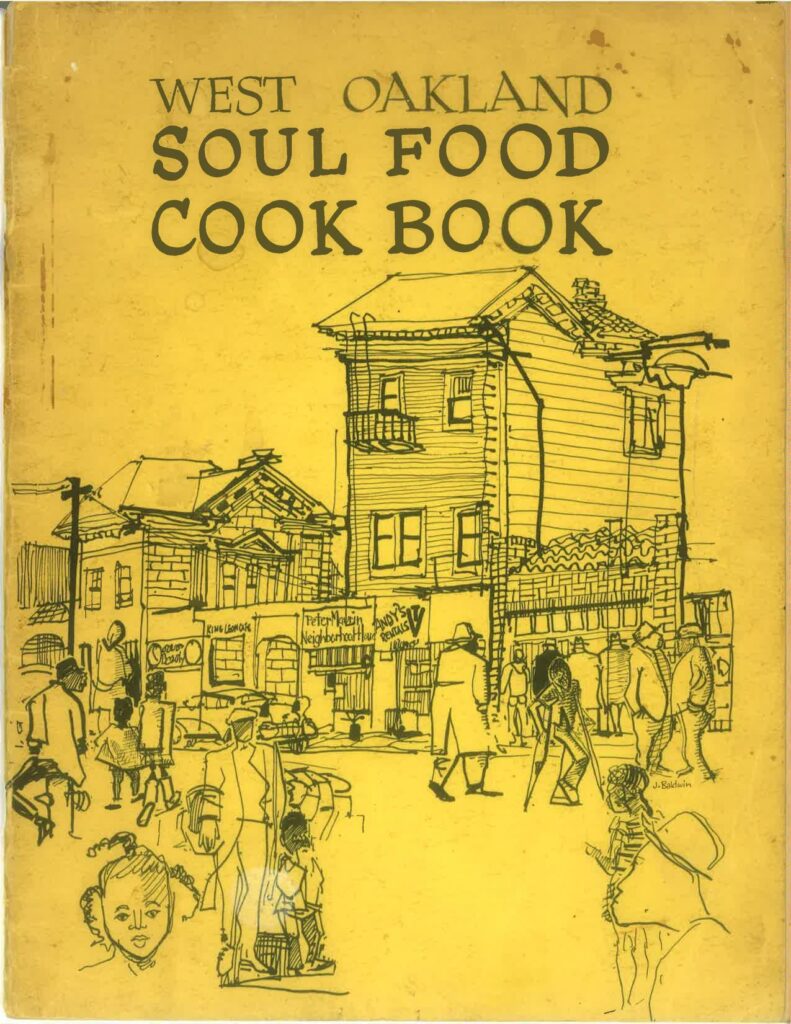
This was a published project of art and recipes created by folks in the neighborhood in the 1960’s. Vest has an original copy. You can also have your own. Download the entire book for free right here.
But now it is time to talk about the actual house.
According to records provided by Oakland Historian Betty Marvin, “The 1883 directory lists the owner/ builder as “Captain State Dredger”. The Stetsons are then listed as owning the property in 1892 though it had a different address and a Miss Lillie J. Stetson, teacher at the ‘West Oakland Free Kindergarten’, is also reported as living there”.
So we go back.
The 1880’s in West Oakland became a haven for a small but politically prominent Black population. As a new frontier for those traveling away from the ravages of a post-civil war South, and I will also argue, the Northeast, it was a place to build a future.
Little is recorded about Captain State Dredger but for reference, just a few blocks away at 1782 8th street is one of the oldest houses in West Oakland built by Captain William Thomas Shorey. A sea captain from Barbados, he made his fortune in the maritime trade. In the 1880s, he married Julia Ann Shelton. “Her grandfather, Samuel Shelton, was brought west as an enslaved person in the 1840s and ultimately purchased his own freedom and that of his family in the new state of California. She attended the Phoenixonian Institute in San Jose, the first school in California where Black Americans could receive a secondary education. She often sailed with her husband and described her experiences abroad to her home community in letters to the editor published in the Black-owned newspaper, The San Francisco Elevator”. During her land life, she served as the president of the Home for Aged and Infirm Colored People of Oakland.
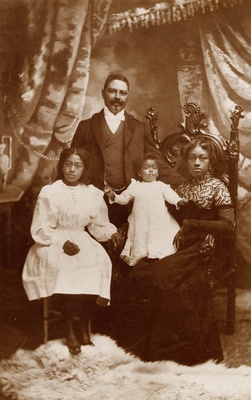
Shorey family, c.1899 Photo from San Francisco Maritime National Historical Park Research Center. P00.21578x. Wikilinks
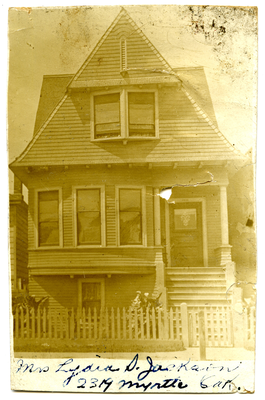
The Flood Family also built a house during that era in West Oakland. Exterior of Lydia Flood Jackson’s house at 2319 Myrtle St., Oakland, California. Circa 1900s. Oakland Public Library, African American Museum and Library at Oakland.
The Shorey House is honored with a plaque but the interior has long been gutted and turned into apartments. Nothing but the facade remains. By the turn of the century, few migrating to West Oakland had the funds to build grand houses but they likely rented rooms in them, “The 1924 directory lists Joseph Silva, ‘clerk,’ at 831 Center. In 1936, the resident was listed as Lula Campbell”. Did Lula perhaps regularly go to visit the clubs along 7th street, then often called the Harlem of the West? After all, the house was only two streets away from all the excitement. Excitement that included the profound artistry of Duke Ellington, Billie Holiday, and Big Mama Thornton.
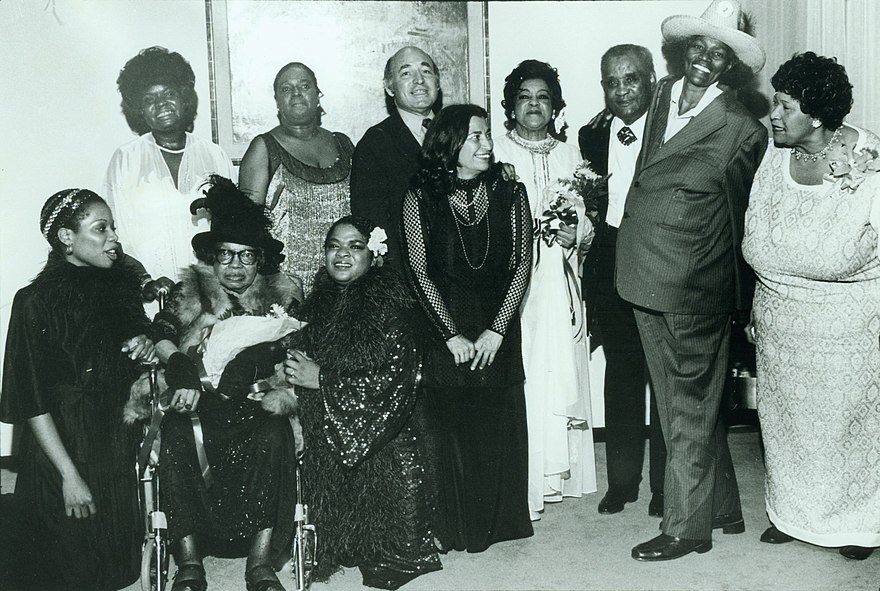
Big Mama Thornton in suit amongst other greats. Courtesy of Wikipedia. Also, you should listen to her right here.
Shiny cars of chrome and leather lined up for blocks waiting to dispense fancily dressed patrons eager to go into Esther’s Orbit Room and Slim Jenkins. I don’t want to assume anything about the woman named Lula, but I like to imagine she might have been a performer. Regardless, what a time that must have been! A time that can be very difficult to imagine now as 7th street, despite recent recognition of its history, resulting from yet another wave of poorly planned development, is a sorrowful representation of what it once was.
As for the Mural house, there are tax records for those who occupied it during the ensuing decades but how they lived can only be guessed at. What is known is that Ms. Ruby lived in that house by the 70’s, spending much time on the porch and known by every child on the block. She passed away around 1989.
By the time Vest put a bid on the house ten years later, it was entirely derelict. The Loma Prieta Earthquake that brought down the Cypress Freeway had also brought down half of the roof. “Squatters had long moved in, there was a sex worker running her business in the basement and trash, including the skeletons of dead animals, was piled six feet high in the backyard”.
Why then, did she put in a bid?
“I did research on West Oakland mid-90s when I was working at a nonprofit in Downtown Oakland called OCCUR – the Oakland Community Council on Urban renewal – addressing the issues of redlining and eminent domain. I’d lived in San Francisco and around Oakland but I had never been to West Oakland and when I first visited, learning of the history, I said I want to live here, I want to buy a house here.
I wanted to buy a house here because of the Black Panthers’ legacy. But way before the Black Panthers, the powerful legacy of this Black community – the 7th street corridor, the migration from the south, and Marcus Garvey’s UNI building. To think that Garvey used to just be a block from my house holding meetings and creating change is profound.”
Yet, it was an intense labor of love to repair the house as she didn’t have significant funds for renovations. It took over two and half years and it did indeed take much community effort. Friends helped to haul out the trash. Friends helped to paint. Friends helped to cook for those who were working. Vest often stayed on friend’s couches while the house was made livable, while the roof was being replaced, while old, moldy plaster was taken out, while new electrical and plumbing was installed and while she continued to powerfully insist with the contractors that were hired that she wanted to preserve the character of the house if not the old plaster. “They wanted to do it the easy, cheap, fast way and I had to keep saying, over and over ‘no, no, no! keep the good bones, bring back its original beauty!”.
It is again, indeed, a beautiful house. Leading up to the 2nd floor, is the original wooden banister, over a century old, well oiled by many hands. As we were walking through the house, I mentioned that there must have been many kids way back when, in their nightgowns, who leaned over that bannister to watch their families having a party downstairs, perhaps while a piano was played in the parlor. “Yes, like ‘Meet Me in St. Louis’”, said Vest smiling.
The significant difference from the film being of course, that the children leaning over the banister were Black.
Any old house holds the resonance of all who have lived in it. The griefs and joys expressed amongst the walls vibrate, the clamor of great celebrations ring still – if only faintly – and the dreams from all who rested their head there can still be heard if you listen well enough. But there is a presence that has lingered. Jewelry has been known to disappear and then reappear in surprising places, almost as though they are a gift. Vest’s neighbor, who has lived on the block since the 50s says, “That’s Ms. Ruby, she loved jewelry”. She’s still keeping an eye on the place and giving those who live in it her love.
Because Love is what this house is all about.
On February 12th, 2023 the Mural House hosted a great block party. There was a DJ, there was BBQ, there was face painting for the kids, there was even a tiny makeshift bar set up on a card table. The highlight however was seeing the People’s Free Food Program back in action – Vest and her team of volunteers offered groceries to anyone and everyone.
So go visit the museum. Go visit the mural. Go be part of the love.
And while you are there, maybe spare a thought for ‘Jason’, the 8 year old who recently visited the museum and wrote in the book offered to guests, “I really enjoyed learning about the Black Panther Party”. He just might grow up to be one who continues the care.
To learn more, visit and to donate go to https://westoaklandmuralproject.org
Follow @westoaklandmuralproject on Instagram
You can also donate to the food drive for the next block party in June using the QR code on the flyer.


